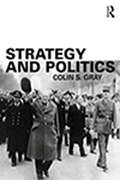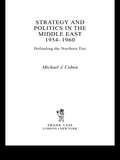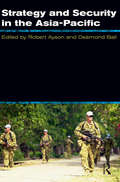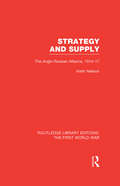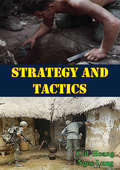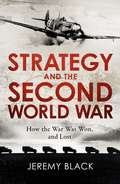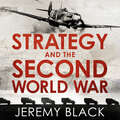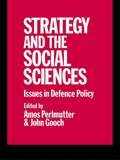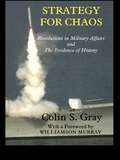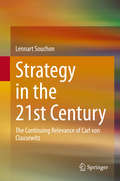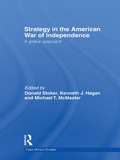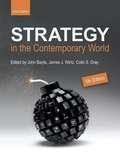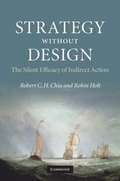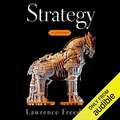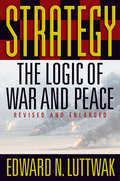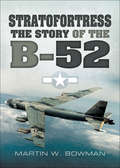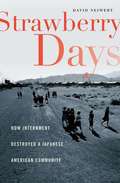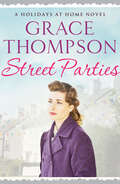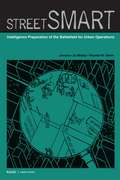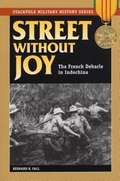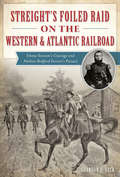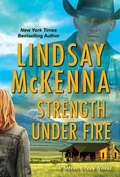- Table View
- List View
Strategy and Politics
by Colin S. GrayThis book examines the subject of strategy and its relationship with politics. Despite the fact that strategy is always the product of political process, the relationship between the two concepts and their ancillary activities has scarcely been touched by scholars. This book corrects that serious deficiency, and explains the high relevance of political factors for matters of general defence. Each chapter aims to show how and why strategy and politics interact and how this interaction has had significant consequences historically. Neither strategy nor politics can make sense if considered alone. Strategy requires direction that can only be provided by political process, while politics cannot be implemented without strategy. In summary, this volume will explain: what strategy is (and is not) why strategy is essential what strategy does and how it does it how strategy is made and executed Written by a leading scholar and former practitioner, this book will be essential reading for all students of military strategy, strategic studies, security studies and war and conflict studies.
Strategy and Politics in the Middle East, 1954-1960: Defending the Northern Tier
by Michael CohenThe period covered by this book witnessed a significant change in Allied strategy for the Middle East. Its focus switched from Egypt to the states of the so-called northern tier of the Middle East: Turkey, Iraq, Iran and Pakistan. This book reveals the extent to which the UK clung on to great-power pretensions and used bluff, even deception, in order to give the impression that it disposed of greater military resources than was in fact the case. It describes not only Anglo-American tensions in the Middle East, but also the Americans' reluctance to take over Britain's former hegemony in the region. Finally, it reveals the extent to which the Allies' relationship with Israel was a constant restraint upon their freedom of action in the area, and their ability to forge military alliances with Arab states.
Strategy and Security in the Asia-Pacific: Global and regional dynamics (Canberra Papers On Strategy And Defence #No. 139)
by Robert Ayson Desmond BallFrom the war on terror to the rise of China, this book unlocks the major strategic themes and security challenges of the early twenty-first century. Strategy and Security in the Asia-Pacific provides the analytical frameworks needed to make sense of this complex but exciting strategic universe. Offering a unique mix of global strategic thinking and Asia-Pacific security analysis, this book is for readers from Sydney to Seoul who want to put their own local security challenges in a wider regional and global context. It is also for North American and European readers requiring an understanding of the dynamic security developments in the Asia-Pacific region around which so much of global strategy is increasingly based. The really vital questions facing the international community are dealt with here: Why do governments and groups still use armed force? Has warfare really changed in the information age? Why should we be concerned about non-traditional security challenges such as water shortages and the spread of infectious disease? Is a great clash imminent between the United States and China? What are the prospects for peace on the Korean peninsula and between India and Pakistan? Can Southeast Asia survive the challenges of transnational terrorism? What does security mean for the Pacific island countries and for Australia and New Zealand? With contributions from leading commentators and analysts, Strategy and Security in the Asia-Pacific offers a comprehensive and authoritative introduction to the field.
Strategy and Supply: The Anglo-Russian Alliance 1914-1917 (Routledge Library Editions: The First World War)
by Keith NeilsonBased on a wide range of primary sources, this book shows the way in which diplomacy, economics, finance and strategy became intertwined during the First World War. The author examines the diplomatic, economic, financial and military relations between Britain and Russia and argues that the key to understanding the alliance is the British determination to win the war and the role Russia played in achieving this aim. British strategy is shown to be more the result of her relations with her allies, especially during the first years of the war, than a quarrel between East and West. This revision of the accepted interpretation of the strategy leads to a reassessment of the views of Lloyd George, Kitchener and Grey. The author concludes that in 1917 the British interest in Russia remained as it was earlier in the war: the maintenance of a powerful ally on the eastern front.
Strategy and Tactics (Indochina Monographs #1)
by Col. Hoang Ngoc LungIncludes over 10 maps and illustrationsThis monograph forms part of the Indochina Monograph series written by senior military personnel from the former Army of the Republic of Vietnam who served against the northern communist invasion."During the war years, the Republic of Vietnam and the United States pursued a common goal; their armed forces fought against the same enemy, under the same campaign plan, with the same weapon systems, and in the same environment.The strategic approaches to fighting this war, however, evolved through several stages depending on the enemy's kind of warfare and force structure; so did the tactics designed to counter his large-unit and guerrilla activities. This monograph endeavors, therefore, to trace back and evaluate our strategic alternatives at each stage of the war and the evolving tactics employed, with particular emphasis on the period of American withdrawal and reduced support.In the preparation of this monograph, I have expressly confined my discussions of strategy to its military aspect. While this conforms to the limited scope of a military subject, the encompassing nature of strategy, especially one conceived to face the enemy's approach to total war, implies that for a better understanding of military strategy, the interplay of social, political, and economic factors should also be brought in as a backdrop. Therefore, wherever appropriate, I have found it necessary to place strategic discussions in the total war context."-Author's Introduction.
Strategy and the Second World War: How the War was Won, and Lost
by Jeremy BlackA concise, accessible account of strategy and the Second World War. How the war was won . . . and lost..In 1941, the Second World War became global, when Nazi Germany attacked the Soviet Union; Japan attacked the United States at Pearl Harbor; and Germany declared war on the United States.In this timely book, which fills a real gap, Black engages with the strategic issues of the time - as they developed chronologically, and interacted - and relates these to subsequent debates about the choices made, revealing their continued political resonances.Beginning with Appeasement and the Soviet-German pact as key strategic means, Black examines the consequences of the fall of France for the strategies of all the powers. He shows how Allied strategy-making was more effective at the Anglo-American level than with the Soviet Union, not only for ideological and political reasons, but also because the Americans and British had a better grasp of the global dimension.He explores how German and Japanese strategies evolved as the war went badly for the Axis powers, and discusses the extent to which seeking to mould the post-war world informed Allied strategic choices from 1943 onwards, and the role these played in post-war politics, notably in the Cold War. Strategy was a crucial tool not only for conducting the war; it remains the key to understanding it today.
Strategy and the Second World War: How the War was Won, and Lost
by Jeremy BlackA concise, accessible account of strategy and the Second World War. How the war was won . . . and lost..In 1941, the Second World War became global, when Nazi Germany attacked the Soviet Union; Japan attacked the United States at Pearl Harbor; and Germany declared war on the United States.In this timely book, which fills a real gap, Black engages with the strategic issues of the time - as they developed chronologically, and interacted - and relates these to subsequent debates about the choices made, revealing their continued political resonances.Beginning with Appeasement and the Soviet-German pact as key strategic means, Black examines the consequences of the fall of France for the strategies of all the powers. He shows how Allied strategy-making was more effective at the Anglo-American level than with the Soviet Union, not only for ideological and political reasons, but also because the Americans and British had a better grasp of the global dimension.He explores how German and Japanese strategies evolved as the war went badly for the Axis powers, and discusses the extent to which seeking to mould the post-war world informed Allied strategic choices from 1943 onwards, and the role these played in post-war politics, notably in the Cold War. Strategy was a crucial tool not only for conducting the war; it remains the key to understanding it today.
Strategy and the Second World War: How the War was Won, and Lost
by Jeremy BlackA concise, accessible account of strategy and the Second World War. How the war was won . . . and lost..In 1941, the Second World War became global, when Nazi Germany attacked the Soviet Union; Japan attacked the United States at Pearl Harbor; and Germany declared war on the United States.In this timely book, which fills a real gap, Black engages with the strategic issues of the time - as they developed chronologically, and interacted - and relates these to subsequent debates about the choices made, revealing their continued political resonances.Beginning with Appeasement and the Soviet-German pact as key strategic means, Black examines the consequences of the fall of France for the strategies of all the powers. He shows how Allied strategy-making was more effective at the Anglo-American level than with the Soviet Union, not only for ideological and political reasons, but also because the Americans and British had a better grasp of the global dimension.He explores how German and Japanese strategies evolved as the war went badly for the Axis powers, and discusses the extent to which seeking to mould the post-war world informed Allied strategic choices from 1943 onwards, and the role these played in post-war politics, notably in the Cold War. Strategy was a crucial tool not only for conducting the war; it remains the key to understanding it today.
Strategy and the Social Sciences: Issues in Defence Policy
by John Gooch Amos PerlmutterThis title available in eBook format. Click here for more information.Visit our eBookstore at: www.ebookstore.tandf.co.uk.
Strategy for Chaos: Revolutions in Military Affairs and the Evidence of History (Strategy and History)
by Colin GrayIn this volume, Professor Colin Gray develops and applies the theory and scholarship on the allegedly historical practice of the 'Revolution in Military Affairs' (RMA), in order to improve our comprehension of how and why strategy 'works'.The author explores the RMA hypothesis both theoretically and historically. The book argues that the conduct of an RMA has to be examined as a form of strategic behaviour, which means that, of necessity, it must "work" as strategy works. The great RMA debate of the 1990s is reviewed empathetically, though sceptically, by the author, with every major school of thought allowed its day in court.The author presents three historical RMAs as case studies for his argument: those arguably revealed in the wars of the French Revolution and Napoleon; in World War I; and in the nuclear age. The focus of his analysis is how these grand RMAs functioned strategically. The conclusions that he draws from these empirical exercises are then applied to help us understand what, indeed, is - and what is not - happening with the much vaunted information-technology-led RMA of today.
Strategy in the 21st Century: The Continuing Relevance of Carl von Clausewitz
by Lennart SouchonThis book presents a detailed discussion of Clausewitz's principal lines of thought and methods of implementation. It elaborates on his main objective of laying a foundation for the education of up-and-coming creative, knowledgeable and experienced future leaders. The book encourages reflection and study in strategic thinking in order to transform knowledge into genuine capability. The book explores the question of what a twenty-first-century decision-maker can learn from these strategic lines of thought. It bridges the gap between philosophical theory and strategic interaction in conflicts with an equal opponent. Readers learn to understand and employ the clash of wills, attack and defence, and friction, and in essence the necessary virtues of a strategic commander.The findings presented help to identify the essential features in complex decision-making situations and developing possible courses of strategic action from a holistic standpoint. As such, the book is a must read for strategists, business practitioners, and scholars of political leadership and management interested in a better understanding of strategy and decision-making.
Strategy in the American War of Independence: A Global Approach (Cass Military Studies)
by Kenneth J. Hagan Donald Stoker Michael T. McMasterThis book examines the strategies pursued by the Colonies and the other combatants in the American War for Independence, placing the conflict in its proper global context. Many do not realize the extent to which the 1775 colonial rebellion against British rule escalated into a global conflict. Collectively, this volume examines the strategies pursued by the American Colonies, Great Britain, France, Spain, and Holland, and the League of Armed Neutrality, placing the military, naval, and diplomatic elements of the struggle in their proper global context. Moreover, assessing how each nation prosecuted their respective wars provides lessons for current students of strategic studies and military and naval history. This book will be of great interest to students of strategic studies, American history, Military History and political science in general. Donald Stoker is Professor of Strategy and Policy for the US Naval War College’s Monterey Program in Monterey, California. He joined the Strategy and Policy faculty in 1999 and has taught both in Monterey and Newport. Kenneth J. Hagan, Professor Emeritus, the U.S. Naval Academy, is currently Professor of Strategy and Policy for the U.S. Naval War College’s Monterey Program. Michael T. McMaster is a Professor at the U.S. Naval War College in Monterey. He is a retired U.S. Navy Commander.
Strategy in the Contemporary World: An Introduction to Strategic Studies, Fifth Edition
by James J. Wirtz John Baylis Colin S. GrayStrategy in the Contemporary World brings together world leading experts to provide a comprehensive introduction to the role of military power in today's world. The definitive textbook on the subject, the fifth edition explores both the enduring and historical issues which have shaped the study of strategy and the contemporary issues that dominate today's headlines.
Strategy without Design: The Silent Efficacy of Indirect Action
by Robert C. H. Chia Robin HoltStrategy exhibits a pervasive commitment to the belief that the best approach to adopt in dealing with affairs of the world is to confront, overcome and subjugate things to conform to our will, control and eventual mastery. Performance is about sustaining distinctiveness. This direct and deliberate approach draws inspiration from ancient Greek roots and has become orthodoxy. Yet there are downsides. This book shows why. Using examples from the world of business, economics, military strategy, politics and philosophy, it argues that success may inadvertently emerge from the everyday coping actions of a multitude of individuals, none of whom intended to contribute to any preconceived design. A consequence of this claim is that a paradox exists in strategic interventions, one that no strategist can afford to ignore. The more single-mindedly a strategic goal is sought, the more likely such calculated instrumental action eventually works to undermine its own initial success.
Strategy: A History
by Lawrence FreedmanIn Strategy: A History, Sir Lawrence Freedman, one of the world's leading authorities on war and international politics, captures the vast history of strategic thinking, in a consistently engaging and insightful account of how strategy came to pervade every aspect of our lives. <p><p> The range of Freedman's narrative is extraordinary, moving from the surprisingly advanced strategy practiced in primate groups, to the opposing strategies of Achilles and Odysseus in The Iliad, the strategic advice of Sun Tzu and Machiavelli, the great military innovations of Baron Henri de Jomini and Carl von Clausewitz, the grounding of revolutionary strategy in class struggles by Marx, the insights into corporate strategy found in Peter Drucker and Alfred Sloan, and the contributions of the leading social scientists working on strategy today. The core issue at the heart of strategy, the author notes, is whether it is possible to manipulate and shape our environment rather than simply become the victim of forces beyond one's control. <p><p> Time and again, Freedman demonstrates that the inherent unpredictability of this environment - subject to chance events, the efforts of opponents, the missteps of friends - provides strategy with its challenge and its drama. Armies or corporations or nations rarely move from one predictable state of affairs to another, but instead feel their way through a series of states, each one not quite what was anticipated, requiring a reappraisal of the original strategy, including its ultimate objective. Thus the picture of strategy that emerges in this book is one that is fluid and flexible, governed by the starting point, not the end point. A brilliant overview of the most prominent strategic theories in history, from David's use of deception against Goliath, to the modern use of game theory in economics, this masterful volume sums up a lifetime of reflection on strategy.
Strategy: The Logic of War and Peace, Revised and Enlarged Edition
by Edward N. Luttwak“If you want peace, prepare for war.” “A buildup of offensive weapons can be purely defensive.” “The worst road may be the best route to battle.” Strategy is made of such seemingly self-contradictory propositions, Edward Luttwak shows—they exemplify the paradoxical logic that pervades the entire realm of conflict. In this widely acclaimed work, now revised and expanded, Luttwak unveils the peculiar logic of strategy level by level, from grand strategy down to combat tactics. Having participated in its planning, Luttwak examines the role of air power in the 1991 Gulf War, then detects the emergence of “post-heroic” war in Kosovo in 1999—an American war in which not a single American soldier was killed. In the tradition of Carl von Clausewitz, Strategy goes beyond paradox to expose the dynamics of reversal at work in the crucible of conflict. As victory is turned into defeat by over-extension, as war brings peace by exhaustion, ordinary linear logic is overthrown. Citing examples from ancient Rome to our own days, from Barbarossa and Pearl Harbor down to minor combat affrays, from the strategy of peace to the latest operational methods of war, this book by one of the world’s foremost authorities reveals the ultimate logic of military failure and success, of war and peace.
Stratofortress: The Story of the B-52
by Martin W. BowmanBoeing's mighty B-52 Stratofortress has seen continuous operational service with the United States Air Force since the type was introduced in 1957. The aircraft has been upgraded several times and has assumed many different new roles since it was originally conceived and then provided the key airborne platform for America's strategic nuclear force. It is predicted that it will serve as a front-line aircraft until 2040.Apart from the formidable threat it provided during the long years of the 'Cold War', the aircraft has played a significant part in all US overseas operations since Vietnam. The more recent include Desert Storm in 1991, the Balkan conflict, Afghanistan and the liberation of Iraq. Over 700 were built and around 80 remain in service. This book includes chapters on Concept Requirement, Design and Development, Production, Evolution and Variant Models, Operational Tasking, Operational History (with first-hand accounts from crews), Weapons and Equipment Carried, Flying the Aircraft and Current Service Operations. t will be highly illustrated with many original shots taken aboard B-52s, together with archive material and also color profiles.
Strawberry Days: How Internment Destroyed a Japanese American Community
by David A. NeiwertImmigrants from Japan began coming to the west coast of the United States toward the end of the 19th century. Along the eastern shore of Lake Washington a community of farmers became highly successful, raising strawberries and an assortment of other fruits and vegetables. Although they were largely accepted by their Caucasian neighbors, underlying prejudice rushed to the surface after the bombing of Pearl Harbor. Based on local histories, newspaper accounts, and extensive interviews, this is a history of the community around Bellevue, Washington, and what became of its Japanese American members during and after the internment.
Stray Angel
by Kay BrellendDiscover the Workhouse to War trilogy by Kay Brellend: a new saga series set in the Whitechapel Union workhouse in East London, between 1904 and 1916. . . 1915, Chrisp Street Market, East London.While the man she loves is fighting on the frontline for his country, Lily Larkin is up at dawn carrying crates of apples to his market stall. Taking charge of Greg's business while he's away, she's grown from a penniless workhouse orphan into a shrewd tradeswoman. But the market is a man's world and Lily soon starts attracting unwanted visitors, including Greg's old rival . . . Luckily, Lily recruits her old friends Margie and Fannie as helping hands. The work is tough, but their friendship pulls them through, and they bear their burdens as cheerfully as their heavy barrows. But the greatest challenge of Lily's life is yet to come. Before dying, her mother gave birth to a child who was spirited away under the cover of darkness. Searching every corner of the city for her long-lost sister, Lily soon discovers there is a world of wickedness within London's poorest alleys. Will Lily find her sister or will her dreams of a family be dashed forever?And as the war in France closes in, can Lily dare to hope that Greg might ask her the one question that would seal her happiness forever?The Workhouse to War series:A Workhouse ChristmasStray AngelPraise for Kay Brellend'Vividly rendered' Historical Novel Society'A fantastic cast of characters' Goodreads'Thoroughly absorbing' Goodreads
Stray Angel (Workhouse to War)
by Kay BrellendDiscover the Workhouse to War trilogy by Kay Brellend: a new saga series set in the Whitechapel Union workhouse in East London, between 1904 and 1916. . . 1915, Chrisp Street Market, East London.While the man she loves is fighting on the frontline for his country, Lily Larkin is up at dawn carrying crates of apples to his market stall. Taking charge of Greg's business while he's away, she's grown from a penniless workhouse orphan into a shrewd tradeswoman. But the market is a man's world and Lily soon starts attracting unwanted visitors, including Greg's old rival . . . Luckily, Lily recruits her old friends Margie and Fannie as helping hands. The work is tough, but their friendship pulls them through, and they bear their burdens as cheerfully as their heavy barrows. But the greatest challenge of Lily's life is yet to come. Before dying, her mother gave birth to a child who was spirited away under the cover of darkness. Searching every corner of the city for her long-lost sister, Lily soon discovers there is a world of wickedness within London's poorest alleys. Will Lily find her sister or will her dreams of a family be dashed forever?And as the war in France closes in, can Lily dare to hope that Greg might ask her the one question that would seal her happiness forever?The Workhouse to War series:A Workhouse ChristmasStray AngelPraise for Kay Brellend'Vividly rendered' Historical Novel Society'A fantastic cast of characters' Goodreads'Thoroughly absorbing' Goodreads
Street Parties (Holidays at Home)
by Grace ThompsonIn a Welsh village, a woman awaits the return of her husband from World War II—while fearing what might have changed while he was away . . . With the war drawing to a close, St David&’s Wells prepares to welcome their soldiers home. Everyone is looking forward to a new dawn. But Alice Castle is suspicious of a strange woman, Netta, who is taking an unhealthy interest in Alice&’s husband&’s return . . . In the captivating conclusion to Grace Thompson&’s historical saga set in a small Welsh village, secrets are revealed, lives take unexpected turns, and the colorful characters of St David&’s Wells mark the historic end of World War II.
Street Smart: Intelligence Preparation of the Battlefield for Urban Operations
by Russell W. Glenn Jamison Jo MedbyIntelligence preparation of the battlefield (IPB), the Army's traditional methodology for finding and analyzing relevant information for its operations, is not effective for tackling the operational and intelligence challenges of urban operations. The authors suggest new ways to categorize the complex terrain, infrastructure, and populations of urban environments and incorporate this information into Army planning and decisionmaking processes.
Street Without Joy: The French Debacle In Indochina (Stackpole Military History Series)
by Bernard B. FallThis book is one of a handful of truly classic accounts of the wars in Indochina. Originally published in 1961, just as the Kennedy administration was escalating the war in Vietnam, it attracted little initial notice in the United States. By 1967, however, when the United States was engaged in full-scale war and the author himself had been killed reporting combat in the very area he had written about, it had become standard reading for the U.S. officer corps in Vietnam. It remains today perhaps the best English account of France’s frustrating and ultimately unsuccessful effort to subdue the Vietminh insurgency. The author came naturally by his chosen profession as a student of war. He grew up in France against the backdrop of World War II, lost both parents in that conflict, and by his own recollection experienced his “first whiff of war” at age twelve. As a teenager, he joined the resistance, and he fought with the Allies in the liberation of France and the drive toward Berlin. This book remains not only a splendid account of a conflict often forgotten in the aftermath of America’s war in Vietnam, but it also speaks directly to a debate that continues to rage among military experts on the nature of the two wars in Indochina and the proper ways to fight them.
Streight's Foiled Raid on the Western & Atlantic Railroad: Emma Sansom’s Courage and Nathan Bedford Forrest’s Pursuit (Civil War Series)
by Brandon H. BeckIn the spring of 1863, Union colonel Abel D. Streight sought to raid and destroy parts of the vital span of the Western and Atlantic Railroad in north Georgia with his mule-riding infantry brigade. Determined to thwart the potentially deadly attack, Confederate general Nathan Bedford Forrest fervently pursued Streight's forces. With the help of unlikely ally fifteen-year-old Emma Sansom of Gadson, Alabama, Forrest falsely convinced Streight he was vastly outnumbered, foiled the raid and forced Streight's surrender. Brandon H. Beck details Streight's dubious plan and the exciting story of a running battle between hunter and quarry that colors history from the hills of northeast Mississippi to the heart of Georgia.
Strength Under Fire (Silver Creek #3)
by Lindsay McKennaNew York Times bestselling author Lindsay McKenna returns to Silver Creek, Wyoming, where a Black Ops veteran finds the strength to fight again when a dangerous terrorist group comes after his beautiful boss . . . Bereft after the brutal loss of her parents, Dana Scott sinks nearly every dime of her inheritance into buying Wildflower Ranch, believing that once she restores the rustic cabin, and farms the untamed acreage, her soul will be whole once more. Hiring wrangler Colin Gallagher to help out just makes sense. But as she works side by side with the handsome loner, she feels an unexpected kinship, and a longing for connection she believed was lost to her forever . . . Colin is only in Silver Creek long enough to make some money and move on. Restless, spiritually broken, the former Army Ranger has nothing left to give after his harrowing time in battle. But helping Dana make a life for herself has him yearning for more. Until the domestic terrorists that destroyed Dana&’s family catch up with her, determined to silence her forever. It&’s a threat that has Colin calling on all his considerable training to keep safe the woman who has taken hold of his heart . . . &“The romance is . . . rich with emotion and intensified by suspense.&”—Publishers Weekly starred review on Silver Creek Fire
